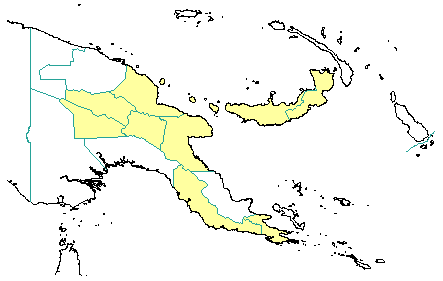
in PNGplants database
PNGTrees – Meliosma pinnata subsp. humulis (Merr. & L.M.Perry) van Beusekom |
Barry Conn (NSW) & Kipiro Damas (LAE).
Copyright held by the authors, Royal Botanic Gardens and Domain Trust, and Papua New Guinea National Herbarium
Blumea Vol. 19: 514 (1971)
Field Characters: Small trees 7-10 m high or large shrub 5-6 m high or large trees 20 m high. Bole cylindrical 20-30 cm diam.; slightly crooked or straight bole 5-15 m long; buttresses absent; spines absent; aerial roots absent; stilt roots absent. Bark grey, pale brown, or white, rough, pustular; lenticels irregular; subrhytidome green; bark thickness <25 mm thick, 5.0 mm thick; blaze consisting of one layer; faintly to non-aromatic; pleasant; outer blaze yellowish brown or yellow, markings absent, granular without splinters; inner blaze yellow or yellowish brown, markings absent, granular without splinters; exudate present, colourless, spotty, changing colour on exposure to air, to brown, sticky. Terminal buds not enclosed by leaves; complex hairs absent; stinging hairs absent; mature twig hairy; hairs dense hairs reddish brown.
Leaves: Spaced along branches <internodes readily visible>. Leaves spiral, compound; petiole present, not winged, attached to base of leaf blade <not peltate>, not swollen; leaves with three leaflets; petiolule slightly swollen <at tip, or base, or both> at base; each leaflet broadest at or near middle or sometimes broadest above middle, 6.0-11.0 (-23.0) cm long, (2.5-) 4.0-6.0 (-9.5) cm wide, leaflets alternate to sub-opposite, almost symmetric or asymmetric, terminal developing leaflet buds straight; venation pinnate <secondary veins arising from the midrib along its length>, secondary veins open <spaced far apart to easily see tertiary veins>, prominent, intramarginal veins absent; lower surface pale green, upper surface dull dark green, hairs present especially on veins or absent, sparse or somewhat dense; oil dots absent; domatia present, scattered along midrib; stipules absent.
Flowers: Inflorescence terminal <at branch ends>. Flowers on a branched axis; flowers unisexual, with male and female flowers on the same plant <monoecious>, flowers stalked, slightly asymmetric, 3.0 mm long, small (< or =10 mm diam.) 4 mm diam.; perianth present, with distinct sepals and petals, white with pink tinge; inner perianth 3, some or partly joined; stamens 2, filaments absent, joined <connate>, free of perianth; ovary superior <seated above petals and sepals; hypogenous>, carpels joined (when more than one) <syncarpous> styles solitary <including joined together>, 1.
Fruits: Fruits arranged on branched axis. Fruit 8-10 mm long, 8.0-10.0 mm diam., fruit red, not spiny, slightly fleshy, simple, indehiscent, drupe. Seeds 1, to about 5 mm long 5-6 mm long, not winged, as wide as long, 1-10 mm diam. 5 mm diam.
Distribution: Southern Highlands, Eastern Highlands, Western Highlands, Madang, Morobe, Central, New Britain & Milne Bay.
 | Botanical records in PNGplants database |
Notes: The lower leaflets of each compound leaf are usually noticeably smaller than the more distal leaflets.
There is considerable variation in leaflet size in this species, as it is currently described. The smaller leaflet variant has leaflets that are mostly 5-10 mm long, 1.5-4 mm wide. This variant is possible more common. Whereas, the larger leaflet variant has leaflets 13-23 cm long and 5-9.5 cm wide.